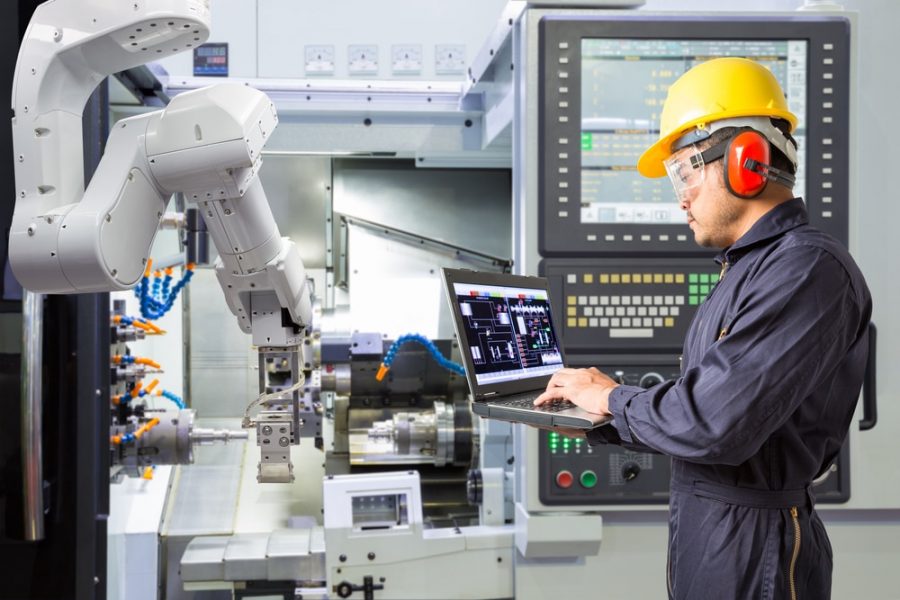When you think of a robot in a manufacturing plant, you may visualize a sizeable mechanical arm assembling car parts, cobot welding electronics, or a device that fills hundreds of food packages every few minutes. These are called industrial robots, which are fully automated to do specialized tasks like pumping, packing, labeling, and more.
But they’re often isolated, working on their own or with their fellow robots. This is because they operate at a fast rate, which may harm humans that come near them. Another downside of such machines is that they’re seen as a threat to human jobs, taking manual work that people used to do.
However, a new breed of machines, known as collaborative robots, is starting to rise in the market, which is specially made to work closely with humans. What does “collaborative robot” mean?
What are Cobots?
Collaborative robots, or “cobots,” are robots that are intended to work hand-in-hand with employees. These machines focus more on repetitive tasks, such as inspection and picking, to help workers focus more on tasks that require problem-solving skills. Since they’re operating next to people, they work at a more manageable speed and have sensors that program the machine to stop immediately when a person makes any contact with them.
Apart from safety, here are other advantages of having a cobot on your production floor.
- A Breeze to Set Up – Unlike their industrial-grade big brothers, cobots are often compact and simple to operate. Setting them up requires little to no programming experience. As such, training your employees to use and program them will be a breeze. Some companies even deploy fully-functional cobots in just weeks. This is compared to industrial bots that need experts to customize and take months to set-up for everyday use.
- Versatile – Cobots are designed to take on different kinds of tasks. As long as you have the suitable end effectors, you can program packing bots to take on labeling or inspecting jobs in just a few minutes. Some cobots are even made to be mobile, so you can easily transfer them to help out another station. They operate much more straightforward than their industrial counterparts, which need extensive changes done to their software and hardware to be repurposed.
- Empowers Employees – Repetitive motions are the leading causes of injury like hernias, carpal tunnel syndrome, and back pain. Back injuries and discomfort were cited in almost 39% of work-related musculoskeletal disorders in the Americal workplaces in 2018, according to the Bureau of Labor Statistics. Cobots can easily take over repetitive manual work for employees. Not only will workers be freed to do more creative tasks, but they’ll also file fewer sick days from workplace injuries.
A Wide Range of Applications
The collaborative robot market is expected to reach a value of over $11.8 billion in 2030, according to analytics firm ABI Research. This is an enormous jump from $711 million in 2019. This optimistic projection comes from the increasing application of cobots across different industries.
The firm also stated that it’s not just big companies utilizing the power of these machines, small to medium businesses are even buying units for manufacturing – from hand guiding cobots, to palletizing cobots, and collaborative robot arms.
Here are some of the industries that make the most out of cobots.
A Hit in Manufacturing
The versatility of cobots has made them a hit in the manufacturing industry. They serve a variety of functions on the production floor. These include:
- All in the Right Place – Cobots like palletizers can be equipped with cameras or sensors that inspect parts of a product for any defects. They can also be used to measure specific components to ensure that they’re being sorted into the right stream in the assembly line.
- Precise Tool Handling – Cobot arms are so accurate that companies are using them to handle process tasks like soldering, screwing, and welding. They can perform these tasks day in and day out (and even after hours) without any slow-downs. They make little to no mistakes, too, so you can rest easy knowing your products have consistently good quality.
- A Perfect Finish – Machines can also be outfitted with force sensors that measure the pressure that the bot exerts on items. Equipped with attachments for sanding, grinding, painting, and more, cobots can provide a consistent finish to any product.
What’s great about these tasks is that they can be transferred easily to other cobots as well. There’s no need to recreate or adjust lines of code. Talk about consistent quality!
Loved in Logistics
Cobots are also well-received in logistics, as they help get deliveries out much faster, which then influences collaborative robot manufacturers to continuously develop more cobot features. A significant example of their use in this field would be in the warehouses of e-commerce giant, Amazon. They’re using cobots that not only transfer items from one place to another but also sense the item’s fragility to adjust their grip accordingly.
Here are other ways collaborative bots are used in logistics.
- Doing the Heavy Lifting – Mobile cobots can be designated to carry loads through a pre-programmed. These minimize the need for workers to take heavy boxes by hand or use heavy equipment like forklifts.
- Sealed and Delivered – Like with part inspection, adding cameras to a bot can turn it into an accurate and efficient picking machine. And with a gripper or suction cups, they can form cartons, load items in, and seal boxes. This makes fulfillment much more efficient and accurate.
Manufacturers of cobots stay updated to deliver the best in operational efficiency without taking away jobs. This is why cobots are a testament that automation and AI aren’t made to replace humans in the assembly line. Instead, they improve the lives of employees on the production floor.
By taking on repetitive tasks, they provide workers with opportunities to take on work that need more creativity than brawn. A cobot palletizer is one example. And because cobots often take on repetitive and sometimes dangerous work, they also keep workplace injuries to a minimum.
The flexibility and safety that cobots provide are why they’re becoming more and more popular with businesses across different industries. And because bots are easy to set up and program, they’re also starting to become a staple in small manufacturing plants. With cobot market values continuing to go up, the future is definitely a collaboration between man and machine.



